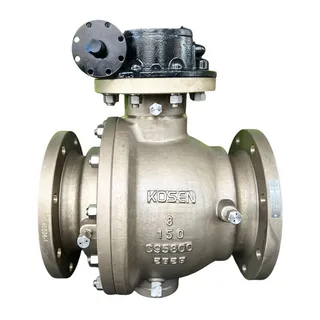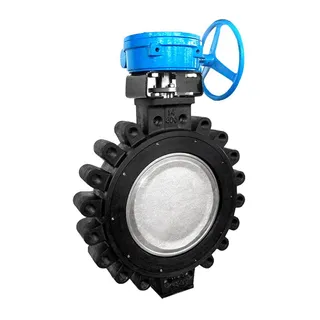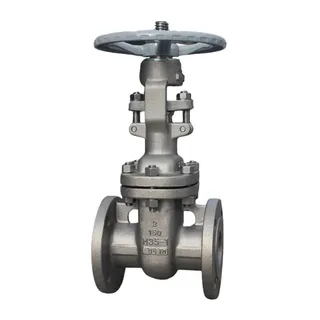In the industrial field, valves are indispensable components of piping systems. They control the flow of fluids and ensure the smoothness and safety of process operations. As a common type of valve, butterfly valves are widely used in various industrial settings due to their unique structure and performance. This article will provide a detailed introduction to the key points of butterfly valve selection, helping you choose the valve that best meets your needs among a wide range of butterfly valve products.
A butterfly valve is a valve with a simple structure and easy operation. Its main component is a disc-shaped plate installed along the diameter of the pipe. The disc rotates around an axis, with a rotation angle ranging from 0° to 90°. When the disc rotates to 90°, the valve is fully open. This structure gives the butterfly valve the following significant characteristics.
The butterfly valve has a relatively simple structure, consisting of only a few components. This design not only reduces manufacturing costs but also gives the valve a clear advantage in size and weight. For example, in some piping systems with limited space, the compact size of butterfly valves makes them an ideal choice.
The operation of a butterfly valve is very simple; a 90° rotation is enough to achieve quick opening and closing. This quick operation makes butterfly valves excel in applications requiring frequent operation. For example, in processes that require rapid switching of fluid flow, butterfly valves can respond quickly, improving operational efficiency.
When fully open, the thickness of the disc is the only resistance to the medium flowing through the valve body. Therefore, the pressure drop generated by a butterfly valve is very small, and it has good flow control characteristics. This means that under the same piping conditions, a butterfly valve can control fluid flow more efficiently while reducing energy loss.
Butterfly valves have two types of sealing: resilient and metal. The sealing ring of a resilient-sealed valve can be embedded in the valve body or attached around the disc. This sealing type is suitable for applications with moderate sealing requirements and offers advantages such as low cost and ease of installation. Metal-sealed valves, on the other hand, have a longer service life and can withstand higher operating temperatures, though their sealing performance is relatively weaker. When selecting the sealing type, one needs to balance the specific process requirements and working environment.
Butterfly valves can be divided into various types based on their structural characteristics. Understanding these types and their applicable scenarios helps make more accurate decisions during selection.
Concentric Butterfly Valve: Also known as a centered butterfly valve, it is suitable for low-pressure and moderate sealing applications, such as water and air regulation. They usually have relatively high sealing performance and low cost.
Double-Eccentric Butterfly Valve: Suitable for medium-pressure applications and some requiring longer service life. The double-eccentric design reduces friction between the seat and the disc, thereby extending the valve's service life.
Triple-Eccentric Butterfly Valve: Suitable for high-pressure and harsh conditions, such as high-temperature or highly corrosive environments. The triple-eccentric structure not only provides tighter sealing as it closes but also reduces operating torque, improving valve efficiency and reliability.
When selecting a butterfly valve, multiple factors need to be considered to ensure that the chosen valve meets process requirements and operates stably over the long term.
Valve strength refers to its ability to withstand the medium's pressure. When selecting a butterfly valve, it is essential to choose an appropriate pressure rating according to the operating pressure of the pipeline. For high-pressure systems, valves with higher pressure ratings should be selected to ensure they can withstand system pressure without leakage or damage. At the same time, operating temperature is another important factor. Different sealing types have different temperature tolerances. For example, resilient-sealed butterfly valves are typically suitable for ambient or low-temperature conditions, whereas metal-sealed valves can withstand higher temperatures.
The characteristics of the medium significantly affect butterfly valve selection. Corrosive media require corrosion-resistant materials, such as stainless steel or PTFE lining, to prevent valve damage and extend service life. In addition, properties like viscosity and density influence flow characteristics and pressure loss. For high-viscosity media, a larger valve diameter may be necessary to ensure sufficient flow.
If the butterfly valve is used for flow regulation, a control-type butterfly valve should be selected. The design of the disc and actuator allows precise flow control. When choosing a control-type butterfly valve, the flow regulation range and precision requirements must be considered to select the appropriate diameter and actuation method. For systems requiring wide-range flow regulation, valves with equal-percentage characteristics should be chosen; for processes requiring precise control, valves with linear characteristics are more suitable.
Good sealing performance is one of the important features of butterfly valves. During selection, it is necessary to ensure that the sealing performance meets process requirements, ensuring complete isolation of the medium when the valve is closed and preventing leakage. For applications with very high sealing requirements, such as in food or pharmaceutical production, high-sealing-performance butterfly valves should be selected.
Butterfly valves can be operated manually, electrically, or pneumatically. The appropriate operation method should be chosen based on process requirements and site conditions. For remote control scenarios, electric or pneumatic butterfly valves should be selected, with consideration of the control signal type and characteristics. Pneumatic operation enables quick response and accurate control, making it widely used in industrial applications.
Connection methods include flange and wafer connections. Selection should be based on the actual piping system. For systems requiring frequent disassembly and maintenance, wafer-connected butterfly valves are more convenient, whereas in high-pressure, large-diameter pipelines, flanged butterfly valves are more stable and reliable.
Due to their unique structure and performance, butterfly valves are suitable for a variety of conditions. Understanding the applicable range helps determine whether a butterfly valve fits your process needs.
The structural principle of butterfly valves is particularly suitable for large-diameter valves. In low-pressure, large-diameter piping systems, butterfly valves can effectively control fluid flow while minimizing pressure loss. For example, in large water pipelines at treatment plants, butterfly valves are ideal flow control valves.
Butterfly valves perform well in flow regulation. Because the disc rotation angle corresponds to flow in a linear or logarithmic manner, precise flow control can be achieved. In pipelines requiring flow regulation, such as material transport in chemical production, butterfly valves are the preferred valve type.
In throttling, regulation, and slurry applications, butterfly valves respond quickly and provide effective throttling control. For example, in oil extraction, butterfly valves are widely used for throttling in mud transport pipelines to regulate flow and pressure.
In special conditions such as high temperature, high pressure, low temperature (cryogenic), or corrosive media, specially designed butterfly valves are required. For example, metal-to-metal line-sealed double-eccentric valves are suitable for urban heating, gas, and water pipelines carrying gas, oil, or acidic/alkaline media, serving as regulating and throttling devices; metal-to-metal surface-sealed triple-eccentric valves are widely used in petroleum, petrochemical, chemical, metallurgy, and power industries, serving as excellent alternatives to gate and globe valves.
When selecting a butterfly valve, the following points should also be considered to ensure the chosen valve meets process requirements and operates stably over the long term:
Butterfly valves generally cause higher pressure loss in pipelines, approximately three times that of gate valves. Therefore, the impact of pressure loss on the system should be fully considered. If the system has strict pressure-loss requirements, a larger-diameter valve may be needed to reduce pressure loss.
In high-temperature conditions, the temperature resistance of elastic seat materials is limited. When selecting resilient-sealed butterfly valves, confirm that the sealing material can withstand the operating temperature to avoid sealing failure.
When closed, the disc must withstand the pressure of the pipeline medium. When selecting a butterfly valve, consider the robustness of the disc to ensure it can operate normally under working pressure without deformation or damage.
Choose appropriate accessories based on actual needs. Common accessories include manual operators, limit switches, and position sensors. These can provide manual operation, position feedback, and other functions to improve convenience and reliability.
Butterfly valves, with their simple structure, easy operation, and good sealing performance, are widely used in various industrial applications. When selecting a butterfly valve, it is necessary to comprehensively consider factors such as operating pressure, temperature, medium characteristics, flow regulation requirements, sealing performance, operation method, and connection type. Proper selection allows butterfly valves to maximize their advantages under various conditions, ensuring normal operation of the piping system and smooth process flow. It is hoped that this article can help you better understand the key points of butterfly valve selection and choose the butterfly valve product that best meets your needs.



